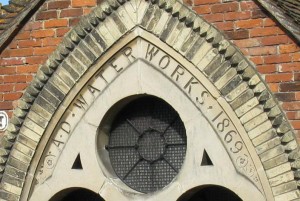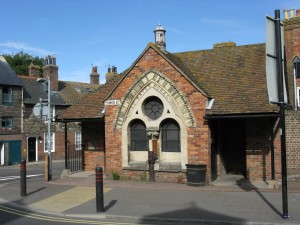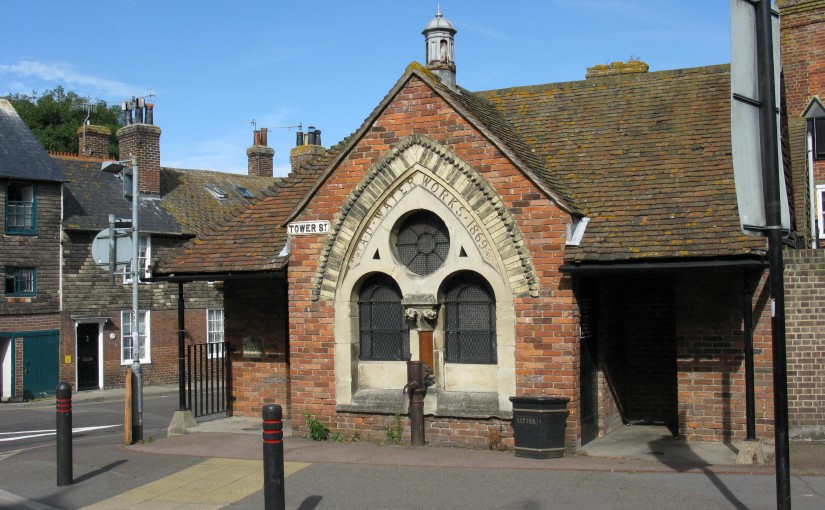How dare Rother District Council even consider selling off the building that fed the town in times of extreme poverty and which has become a friendly landmark set deep in the heart of true lovers of Rye.
The building in question is the former Water Pumping Station that supplied the cistern in Church Square with water from Queen’s Well at the bottom of Deadmans Lane.


Later it was used as a Soup Kitchen, feeding the poverty stricken group of townspeople in times of desperate need. The conversion from Pump House to Soup Kitchen was made shortly before 1900.
Ken Clark’s description of the 1907 bitter cold winter use of the kitchen comes from his “Summary History of Rye” omnibus written for “Rye Own” and first published in the magazine in 1966.
Times of Extreme Hardship
By Kenneth Clarke
Life outside the workhouse was far from easy for, although prices were low, so, too were wages. When unemployment or illness struck, there were no welfare services such as exist in the modern totalitarian state to come to the rescue. Succour in adversity was provided by the comparatively well-to-do classes (much maligned by certain politicians today), who believed they had a responsibility for the welfare of the less fortunate. An outstanding example is provided by John Simonds Vidler whose generosity knew no bounds. The following description of the re-opening of the soup kitchen in 1907 well illustrates the need and the way it was met in adverse times. “The Rye Council Authorities have made arrangements for the distribution of soup and bread to the poor and unemployed of the town.
On Saturday the Town Crier was busy visiting necessitous districts, and announcing to the crowds that gathered at the tintinabulous call of his bell that tickets for soup and bread would be distributed to deserving cases at the Town Hall in the evening.
At six o’clock sharp, on the evening in question, a large and representative party of the fishing and labour fraternity, who had been thrown out of employment or were otherwise afflicted by hard times, assembled at the Town Hall. The cases were heard by officials who made orders for the necessary distribution of bread and soup. No less than 122 tickets were given, and it was decided that the soup kitchen, in Cinque Ports Street should be opened twice a week, on Tuesdays and Fridays during the Cold Weather.
Accordingly, great preparations were made at the Soup Kitchen headquarters, which building, was formerly used as the Town Water Pumping Station, the pumping power of which was “generated” by a couple of horses harnessed to mechanical contrivances.
The two large coppers, each capable of holding 70 gallons of soup, were cleansed, the fuel was got ready, as also were the extensive fireplaces. For four solid hours on Monday a couple of muscular Ryers were kept continually “on the go” peeling potatoes, carrots, parsnips, turnips and onions.
The large quantity of split peas that was also to be used in the soup was soaked in water for the greater part of 24 hours whilst the joints of meat and bones were cut up small.
All night and all morning until eight o’clock, when the Kitchen was declared opened, did the two brawny impromptu cooks attend to the “Roaring and crackling fires and to the steaming cauldrons”
Unceasingly did they manipulate the “stirrers” and spoons, some four feet in length.
At the opening time, and perhaps a little before, the soup was bubbling and gently steaming and was declared by the connoisseurs to be “ready”. On the doors of the building being thrown open the savoury odour of soup permeated the neighbouring streets, from which came, scurrying and running, small boys and girls, carrying such handy receptacles as ewers, watering cans, pots, basins, buckets and other articles, which were well worthy of being exhibited in a curiosity shop.
A number of women and men, mostly past the prime of life and some past the allotted three-score and ten years, also came, and in about an hour’s time no less than 70 gallons of bread and 95 gallons of soup were distributed.
There were altogether 153 applicants. The soup was very good, and did credit to the pair of hard working cooks, who were assisted in the distribution of the hot food and bread by the Mayor (Councillor Kingsnorth Reeve.) Alderman Jarrett, Alderman Neeves, Council
councillor Gasson, Mr. Edwin Dawes, etc.
The soup was made with the following ingredients: 2 bushels potatoes, 1 bushel carrots, 1 bushel turnips, 1/2 bushel parsnips, 1/2 bushel onions, 10 gallons split peas, 40Ils meat and about 35Ibs of bones.
The meat and bones were provided by Messrs. Ashbee and Neeves. Several hundred weights of coal and a bushel of wood were used in cooking the soup”.
“Rye’s Own” Supplement October 2009.
All articles, photographs and drawings on this web site are World Copyright Protected. No reproduction for publication without prior arrangement. © World Copyright 2015 Cinque Ports Magazines Rye Ltd., Guinea Hall Lodge Sellindge TN25 6EG
